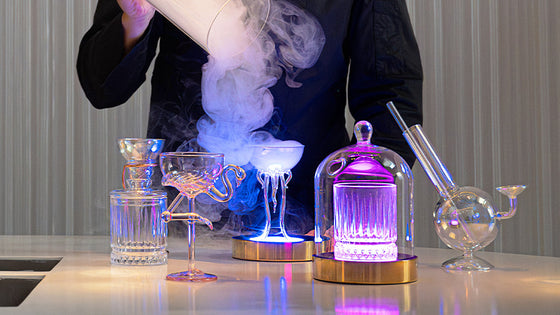How Has Tiki Cocktail History Developed Over the Years?
The history of Tiki culture stems from ancient Polynesia. The word Tiki means large wooden or small greenstone carvings, usually with piercing eyes and menacing scowls. Integral to Southern Pacific culture, these statues are said to represent Polynesian gods. Maori mythology describes Tiki as the first man, and across the Southern Pacific Islands, there are legends about his life and works. The Tiki statues were carved by high-ranking tribesmen and considered sacred. Various rituals and ceremonies were created incorporating the figures for men to talk to the Gods.

The Early Years: Theatre and Escapism
In the late 1920s, a man named Donn Beach (born Ernest Raymond Beaumont Gantt) gained employment aboard a supercargo yacht heading from America to Sydney, Australia, by way of Hawaii. He loved the islands along the way so much that he spent a further year island hopping on freighters. Back home, he gained a reputation for spinning stories of his time at sea.
When Prohibition ended in 1933, he opened a bar in Hollywood called Don's Beachcomber and decorated it with driftwood, bamboo, fishing nets, coconuts and tiki statues. In 1937 the restaurant moved and became Don The Beachcomber. His Zombie cocktail became internationally famous when it was served at the 1939 New York World's Fair.
Beach actively tried to create an escapism atmosphere, even going as far as recreating the sound of monsoon rain falling on the roof of his bar. His motto was, "if you can't get to paradise, I'll bring it to you."
During the Second World War, many men from America were stationed in the South Pacific Islands to defend the States against the Japanese. The G.I.s were often from small towns, and none had ever experienced any other culture than their own. Many of them fell in love and were inspired to bring that feeling home with them when the war ended. One such man, James Michener, became the author of the short story collection called Tales of the South Pacific, which later got turned into a musical by Rodgers and Hammerstein, then a film directed by Joshua Logan. He caught the mood of the nation, and there was a burst of popularity in all things Tiki.
Don Beachcomber's restaurants got swept up in this, and he and his amicable rival Victor Bergeron — who had a restaurant chain called Trader Vicks — hit the boom at the right time. Both men became the owners of extensive chains of Tiki-themed bars and restaurants that proliferated the United States.
The Middle Ages: Fire and Ice
In the 1940s, Donn Beach moved to Hawaii when he settled in Waikiki and opened Waikiki Village, a Polynesian inspired collection of stores, bars and restaurants. He built his office among the branches of an enormous Banyan tree in the centre of the market. The village became a tourist hotspot and, at its height, had nearly 50 shops, nightclubs and restaurants.
However, by the 1980s, Tiki had fallen out of vogue, and the main thrust of cocktail change in the 1990s was towards more traditional bartending. With people in the U.S. and Europe focusing on turn-of-the-century style and flair behind the bar.
However, there were some outliers. Some small independent Tiki bars began to emerge in the 90s, with a focus on integrity as well as fun and escapism.
- The Cacao Coffeehouse in Los Angeles got a Tiki makeover in 1993.
- olitiki opened in Washington D.C. in 1993. These guys were the first to create their own brand of tiki mugs, with caricatures of US presidents.
The Lava Lounge and Hollywood opened in 1993 and was immediately associated with artsy types.
- Sip ’n' Dip Lounge in Montana, opened in 1963, had a rebrand in 1995 when they caught wind of a potential Tiki revival. They specifically wanted to keep the fun factor and put on a mermaid-themed show. In 2002, Daryl Hannah donned her fins and took part. In 2003, GQ magazine listed the lounge on their top 10 bars in the world.
- Lilo Lounge in San Francisco opened in 1996, and caught the attention and of the dot com crowd.
The Naughties until Now: Fun but Tasty
Soon Tiki became associated with a cult of young, creative, but well off nerds, an underground group who were riding the new wave of internet-based communication. Word spread fast. In the year 2000, Sven Kirsten published The Book of Tiki. This was the first chronicle of Tiki’s cohesive history. He connected the dots from decade to decade and city to city.
A slew of new Tiki bars opened all over America throughout the early naughties. In 2006 and 2009, Martin Cate opened Forbidden Island and Smugglers Cove, where he showed how far Tiki could go when discipline was applied to the drinks offering. This excitement spread to the UK when where Trailer Happiness opened in 2004, and Mahiki in 2006.
The most important thing in any tiki bar is that it is fun. The escapism needs to be drawn from a sense of adventure, an open outlook and excitement in discovering the new and unusual. Part of this thrill is the theatre of service. Whether your drinks are served in vessels modelled on volcanoes, or the bartender creates a chain of fire-lit drinks across the bar top, or your server presents your food platter in a ginormous clamshell, the emphasis is always on surprise.
As well as escapism Tiki has risen in esteem, ultimately, because of the taste of the drinks. Punches like the Zombie and Mai Tai remain popular today because they taste amazing. The impact on the senses has to be as dazzling as the theatre. Tiki fell out of fashion because there was not enough emphasis on the quality of the food and drink. The 90s revolution changed that. The smell of cinnamon after its caught fire; the freshness of lime juice at its sharpest; the ice-cold hum between your eyes as your exquisitely chilled Mojito gives you brain freeze on the first sip; these are the pleasures that Tiki drinkers seek. Put your money where your mouth is: deliver the theatre but follow up with flavour.
As Flavoured Blaster was invented specifically to both catch the eye and deliver a genuinely good sensorial hit, it is a natural pairing for Tiki drinksBars like UnderTow in Phoenix and the Why Not Cocktail Lab in Italy use it in their Tiki menus. The range of unusual cocktail glassware, the theatrics of the bubble and smoke, the flavours of the aromatics all fall under the banner of Tiki’s fun but tasty banner.
















